Perfect Picnic Program Components: A teacher’s script, standards alignment information, and Food Safety basics sheet for parents. Two reproducible student activity sheets; a wall poster for the classroom; Powerpoint food safety quiz. (Each item available in English and in Spanish).
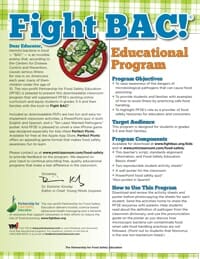
Fight BAC! ® at Picnic Park – Educator’s Guide (English) Includes standards alignment information, food safety education basics sheet and two reproducible activity sheets. Suitable for grades 3-5.
10 Least Wanted Pathogens Poster – Pre-formatted for perfect printing at home or through a professional service. Suitable for grades 3-5.
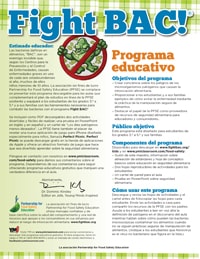
Fight BAC! ® En Pinic Park – Guía del Educador Español – Incluye información de alineación de estándares, información básica de educación sobre inocuidad de los alimentos y dos hojas de actividades reproducibles. Adecuado para los grados 3-5.
The very popular original Your Game Plan for Food Safety middle school curriculum from the Partnership for Food Safety Education. Experiments and activities can be downloaded as separate pages.

Your Game Plan to Food Safety – Comprehensive Teacher’s Guide – the teacher’s activity and experiment guide, a comprehensive guide to teaching FightBAC! in the classroom. Suitable for grades 4-8.
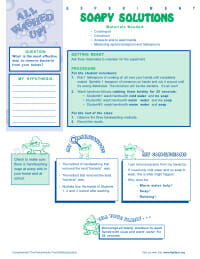
Experiments for Fighting BAC! – Experiments that will help students to learn the importance of proper hand-washing and proper food preparation, cooking and storage in order to FightBAC! Suitable for grades 4-8.
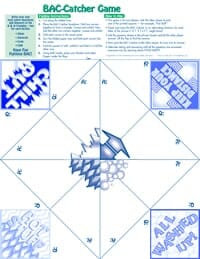
Fight BAC! Game – The BAC Catcher game – a fun tool for teaching children to Fight BAC! Suitable for grades 4-8.
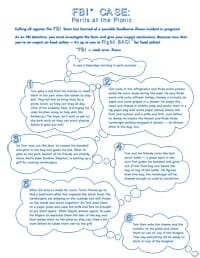
FBI Case: Perils at the Picnic – A case study where children become the detectives on the case of a foodborne illness. Suitable for grades 4-8.
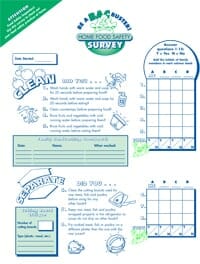
Home Food Safety Survey – A tool for students to use to help them determine if they are fighting BAC! at home. Suitable for grades 4-8.
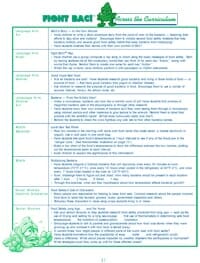
Fight BAC! Activities – Guide for advancing food safety across the curriculum, around your school and around your community. Suitable for grades 4-8.
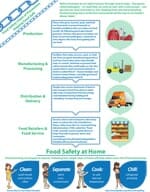
Information Flyer – Food Safety Chain – Keeping food safe and preventing food poisoning starts at the farm and extends all the way to your family’s dinner table! Suitable for grades 6-8.
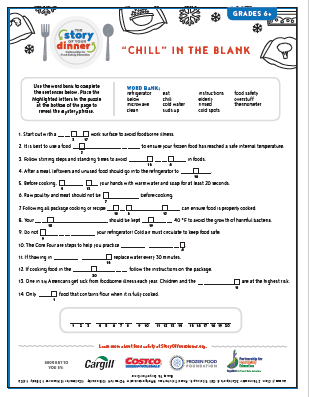
“Chill” in the Blank
Grades 6+
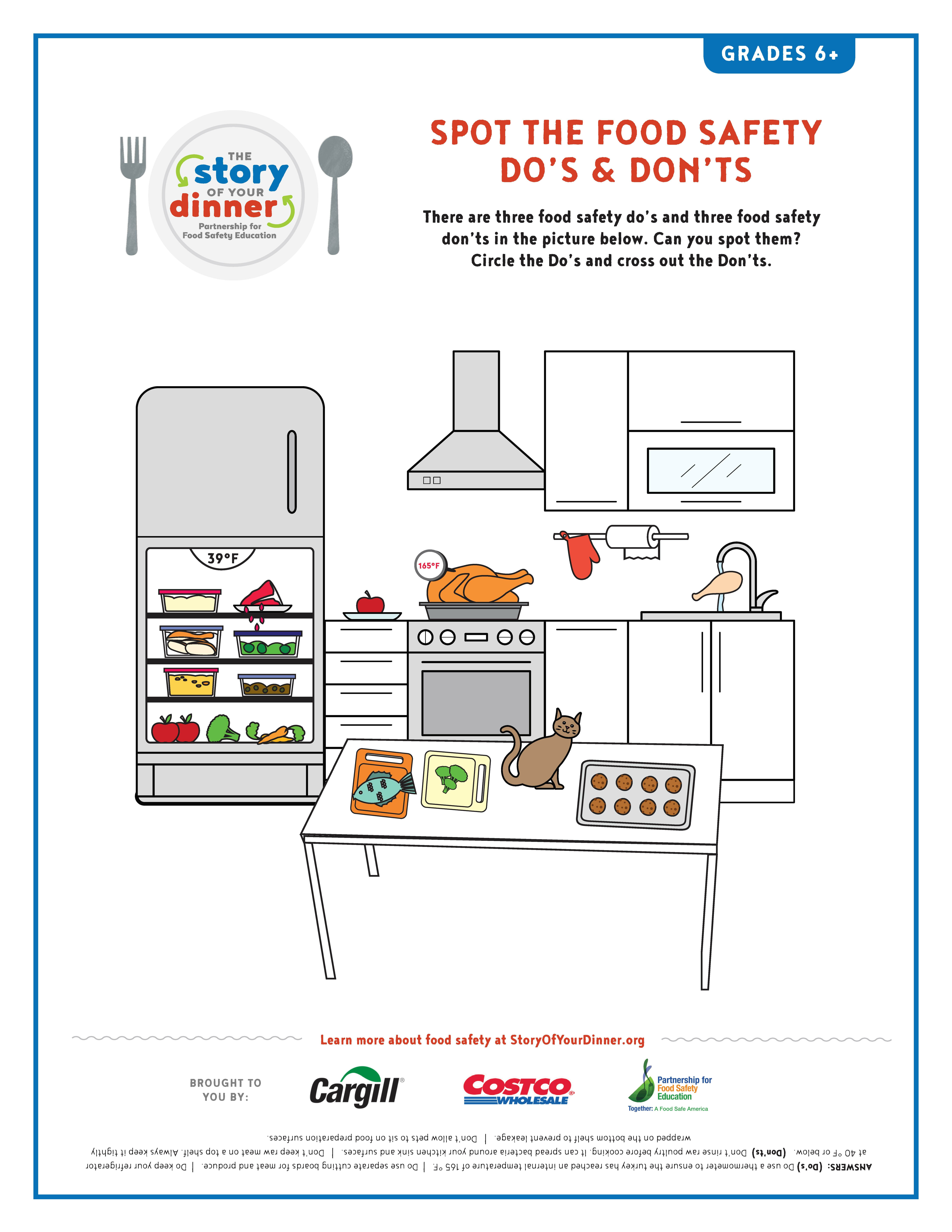
Food Safety Do’s and Don’ts
Grades 6+
 The Hands On Curriculum teaches middle school students key food safety concepts while meeting state-mandated curriculum standards in the core subjects ares of Math, Science, Social Studies and English/Language Arts. Free downloads are available in the Hands On section of the website.
The Hands On Curriculum teaches middle school students key food safety concepts while meeting state-mandated curriculum standards in the core subjects ares of Math, Science, Social Studies and English/Language Arts. Free downloads are available in the Hands On section of the website.
The Safe Recipe Lesson teaches middle school students how to use the Safe Recipe Style Guide to create a recipe that includes basic steps for safe food handling, preparation and storage. The lesson is aligned with National Health and Science Education Standards and has been reviewed by a curriculum specialist. The lesson plan for teachers and student guide are available as separate downloads and include 5 sample recipes.
The Safe Recipe Activity for Middle School is an online activity that teaches students in grades 6-8 how to use the Safe Recipe Style Guide to create a recipe that includes basic instructions for safe food handling, preparation, and storage.
Students can complete the activity independently in about 30 minutes. Internet access and the use of either MS Word or Google Docs are required. You can access the Teacher’s Guide and the online activity for students by clicking the links below.
Perfect Picnic Program Components: A teacher’s script, standards alignment information, and Food Safety basics sheet for parents. Two reproducible student activity sheets; a wall poster for the classroom; Powerpoint food safety quiz. (Each item available in English and in Spanish).

Fight BAC! ® at Picnic Park – Educator’s Guide (English) Includes standards alignment information, food safety education basics sheet and two reproducible activity sheets. Suitable for grades 3-5.
10 Least Wanted Pathogens Poster – Pre-formatted for perfect printing at home or through a professional service. Suitable for grades 3-5.

Fight BAC! ® En Pinic Park – Guía del Educador Español – Incluye información de alineación de estándares, información básica de educación sobre inocuidad de los alimentos y dos hojas de actividades reproducibles. Adecuado para los grados 3-5.
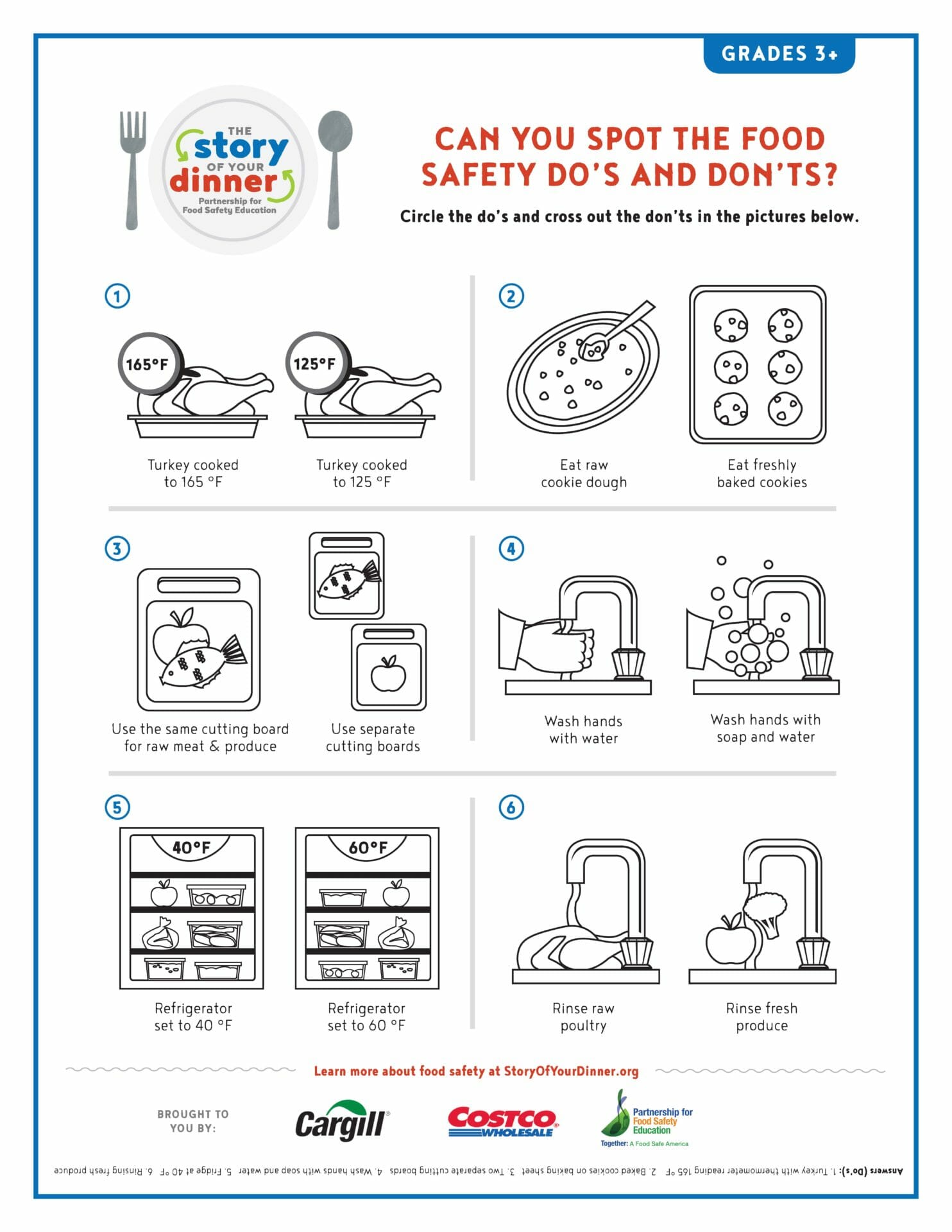
Food Safety Do’s and Don’ts
Grades 3+
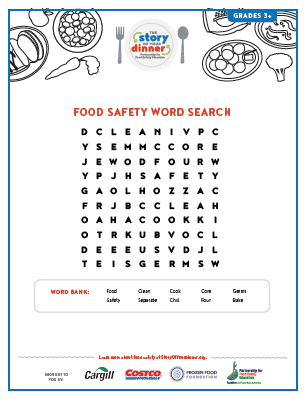
Food Safety Word Search
Grades 3+
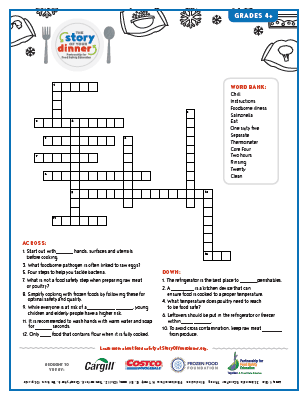
Crossword Puzzle
Grades 4+
The very popular original Your Game Plan for Food Safety middle school curriculum from the Partnership for Food Safety Education. Experiments and activities can be downloaded as separate pages.

Your Game Plan to Food Safety – Comprehensive Teacher’s Guide – the teacher’s activity and experiment guide, a comprehensive guide to teaching FightBAC! in the classroom. Suitable for grades 4-8.

Experiments for Fighting BAC! – Experiments that will help students to learn the importance of proper hand-washing and proper food preparation, cooking and storage in order to FightBAC! Suitable for grades 4-8.

Fight BAC! Game – The BAC Catcher game – a fun tool for teaching children to Fight BAC! Suitable for grades 4-8.

FBI Case: Perils at the Picnic – A case study where children become the detectives on the case of a foodborne illness. Suitable for grades 4-8.

Home Food Safety Survey – A tool for students to use to help them determine if they are fighting BAC! at home. Suitable for grades 4-8.

Fight BAC! Activities – Guide for advancing food safety across the curriculum, around your school and around your community. Suitable for grades 4-8.
Common food safety myths originate from the misapplication of science, family tradition, or misinformation on social media. The Partnership created these social media graphics for consumers and educators to help debunk common home food safety myths. Brush up on safe food handling steps with these food safety Mythbusters!
Flour and other baking ingredients may contain harmful bacteria that are only killed during the cooking process. Children are especially vulnerable to serious foodborne illness.
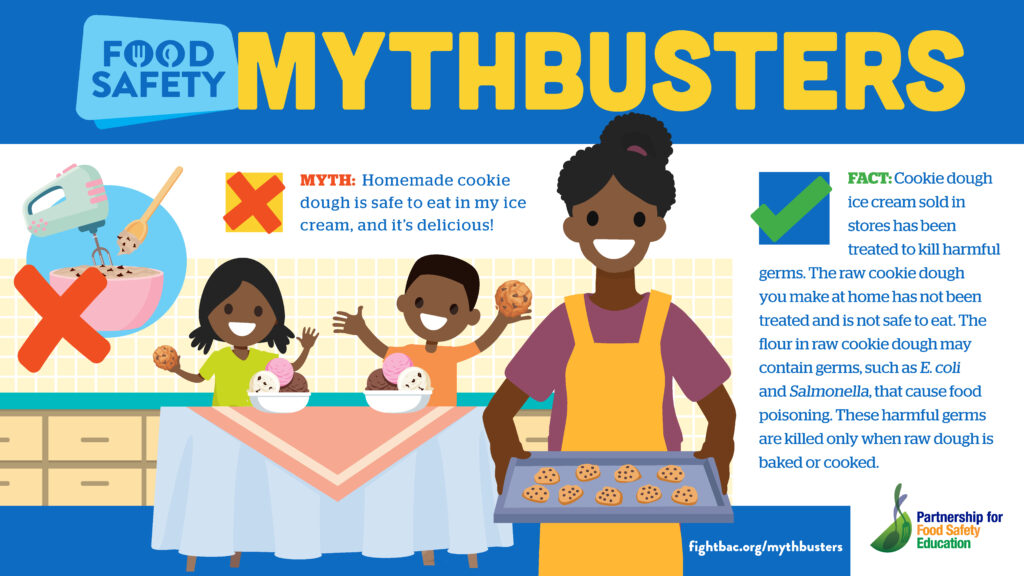
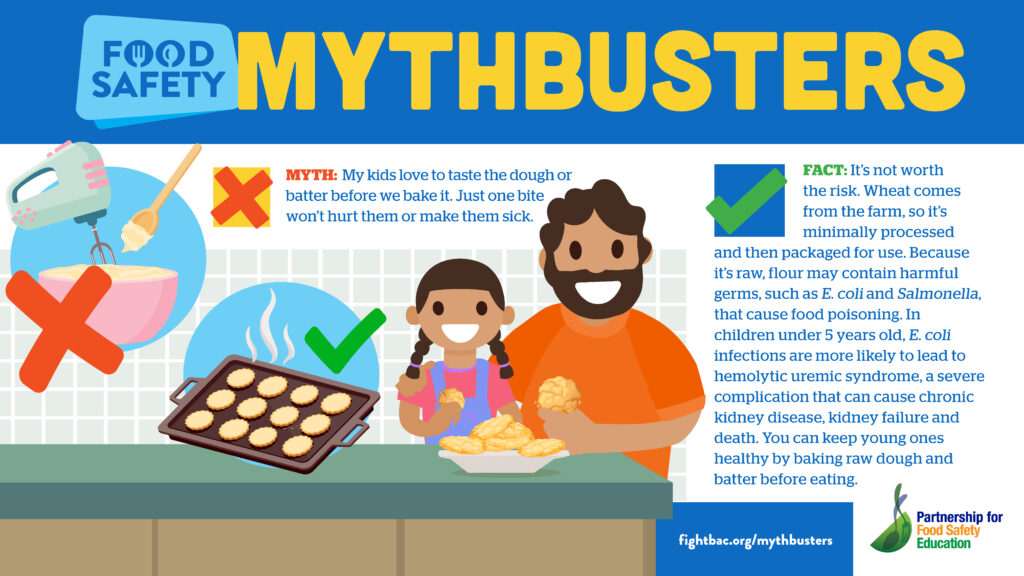
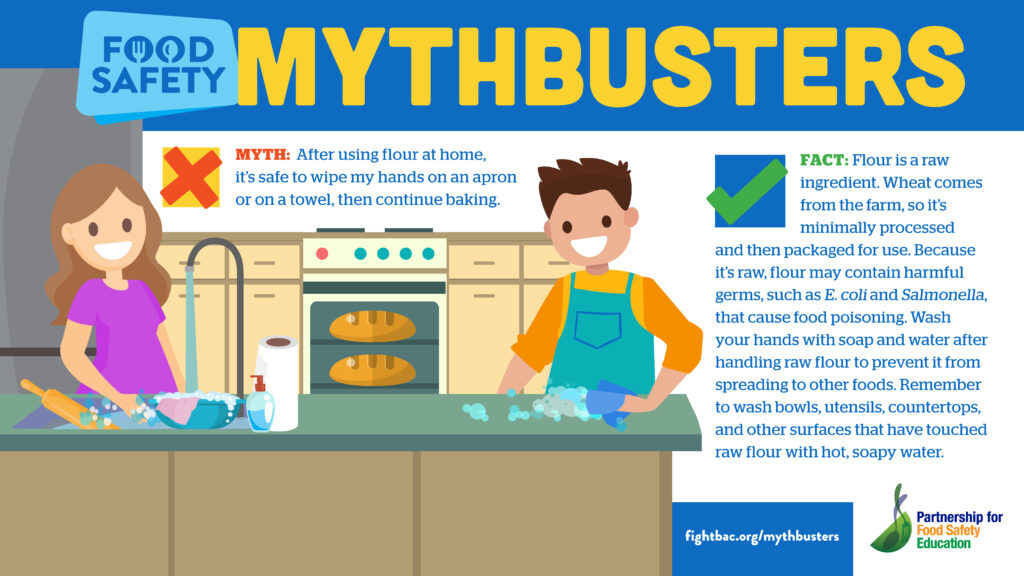
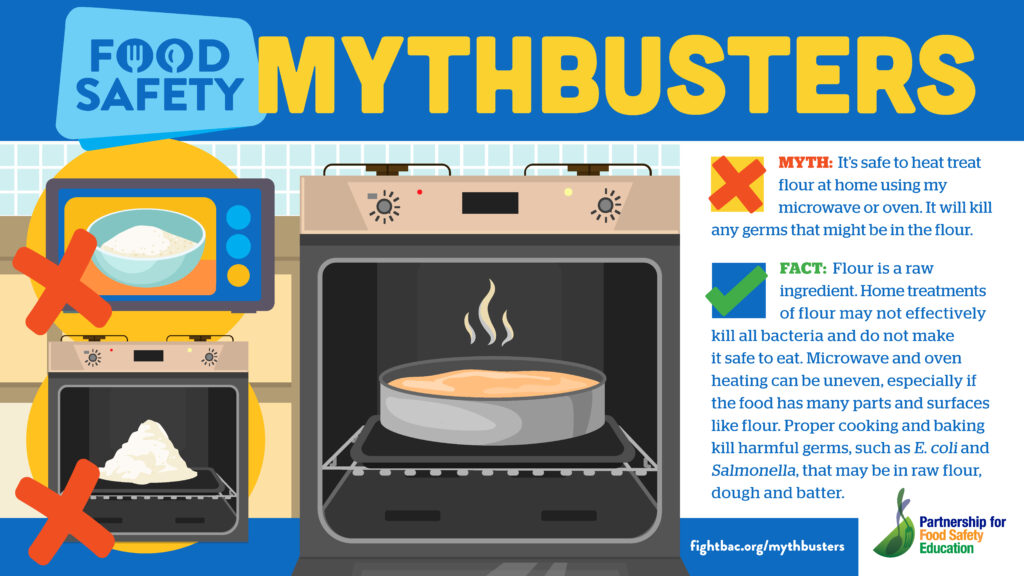
Harmful bacteria can be spread throughout the kitchen and get onto hands, cutting boards, utensils, counter tops and food. Follow these food safety practices to keep you and your loved ones healthy.
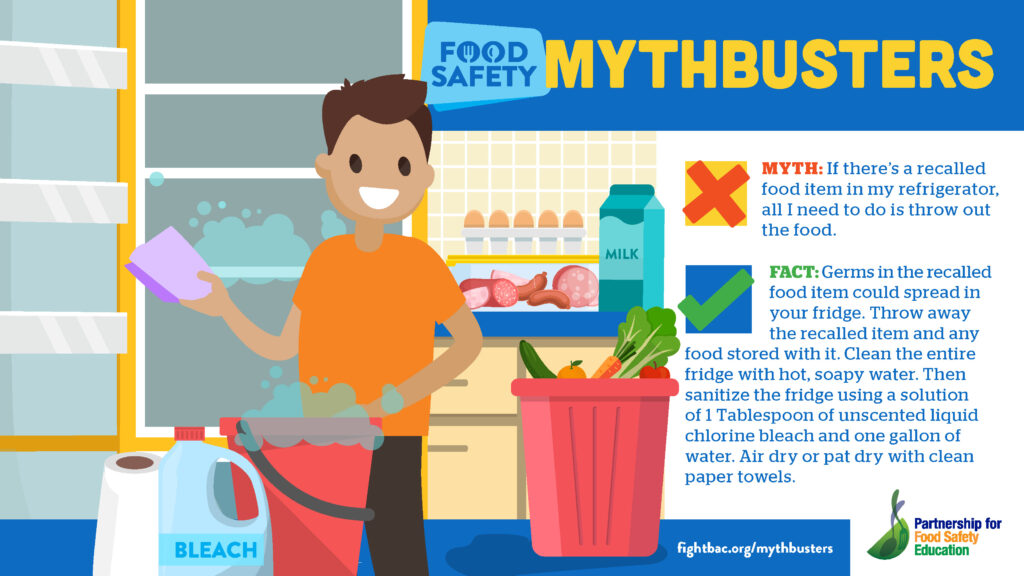
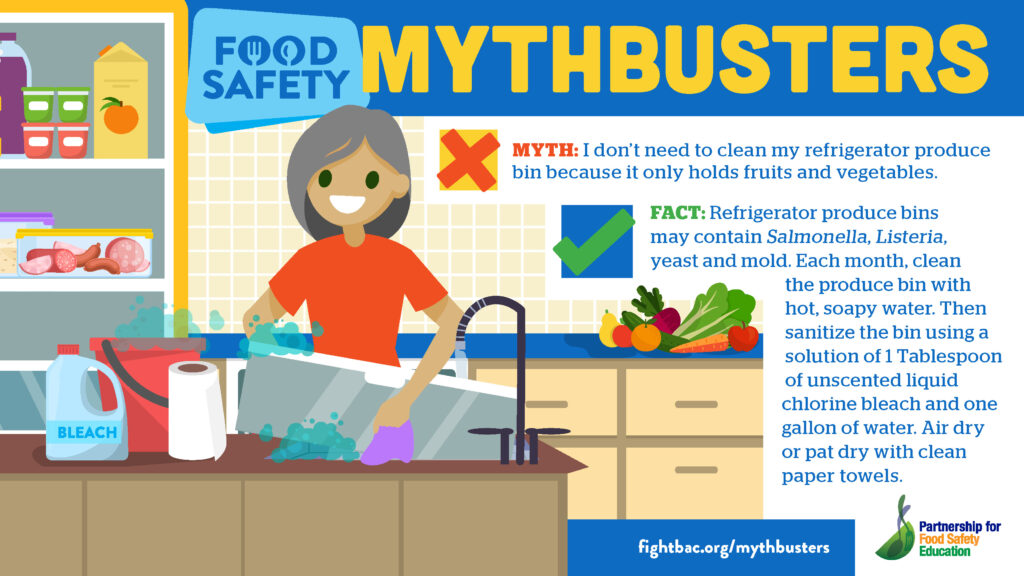
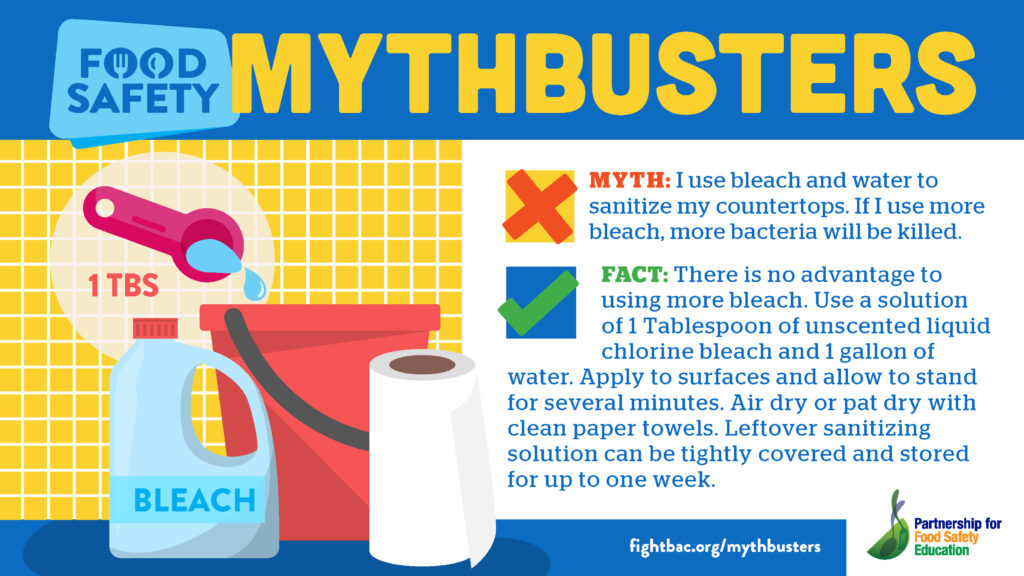
Children younger than age five are at an increased risk for food poisoning and related health complications because their immune systems are still developing. Follow these food safety steps to keep babies and toddlers healthy.

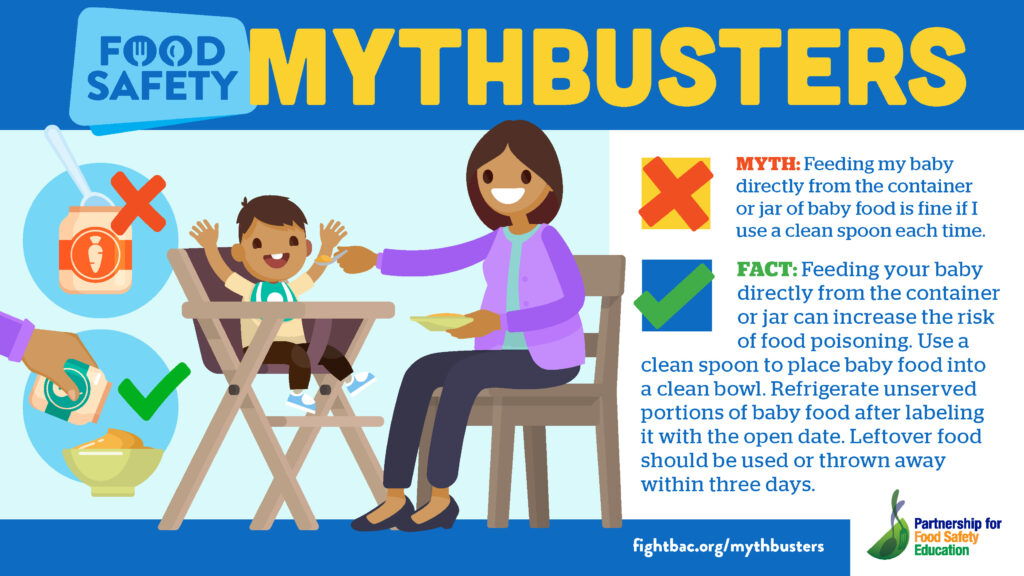
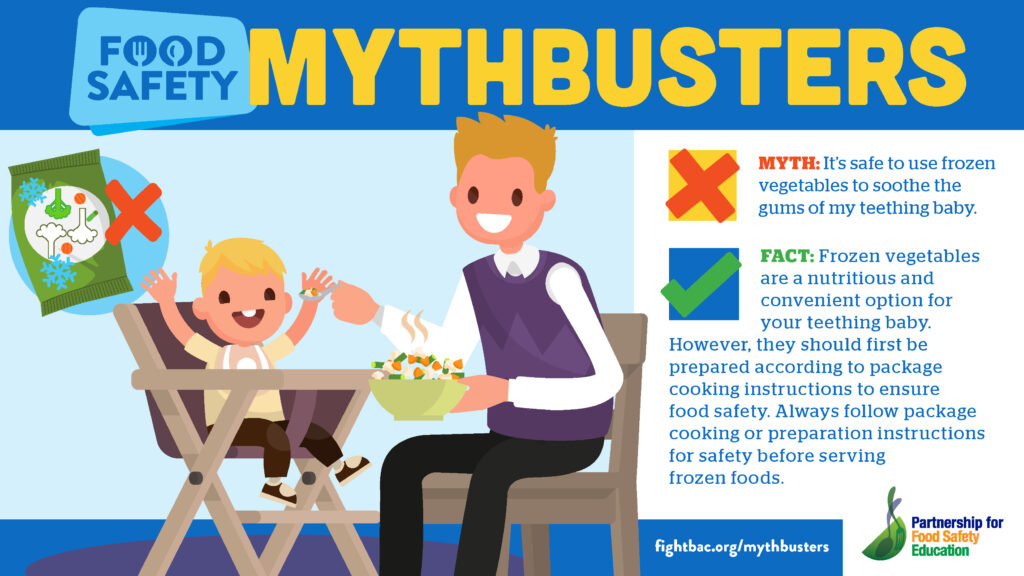
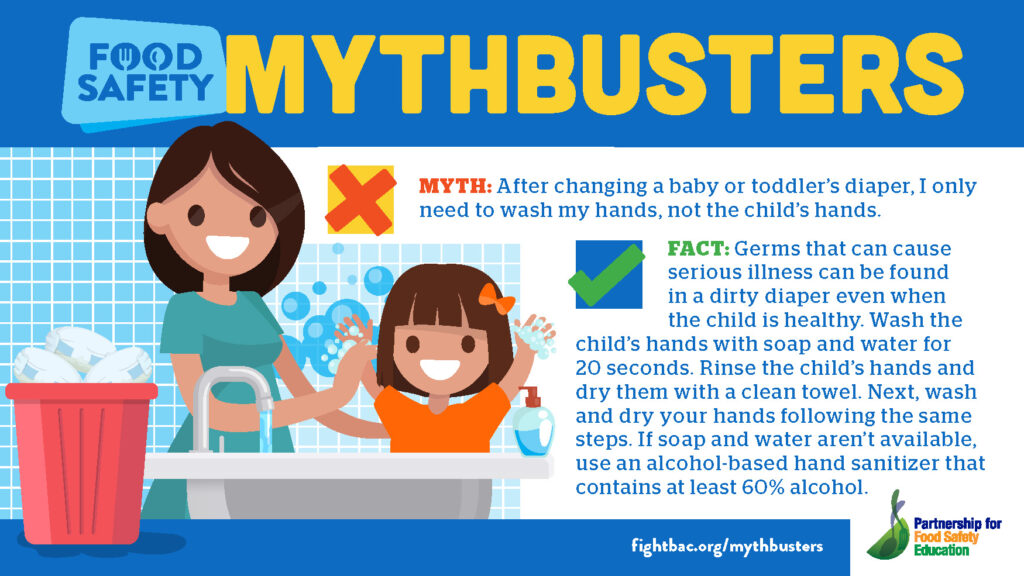
Refrigerate foods quickly because cold temperatures slow the growth of harmful bacteria. Keep a constant refrigerator temperature of 40°F or below to reduce the risk of food poisoning.

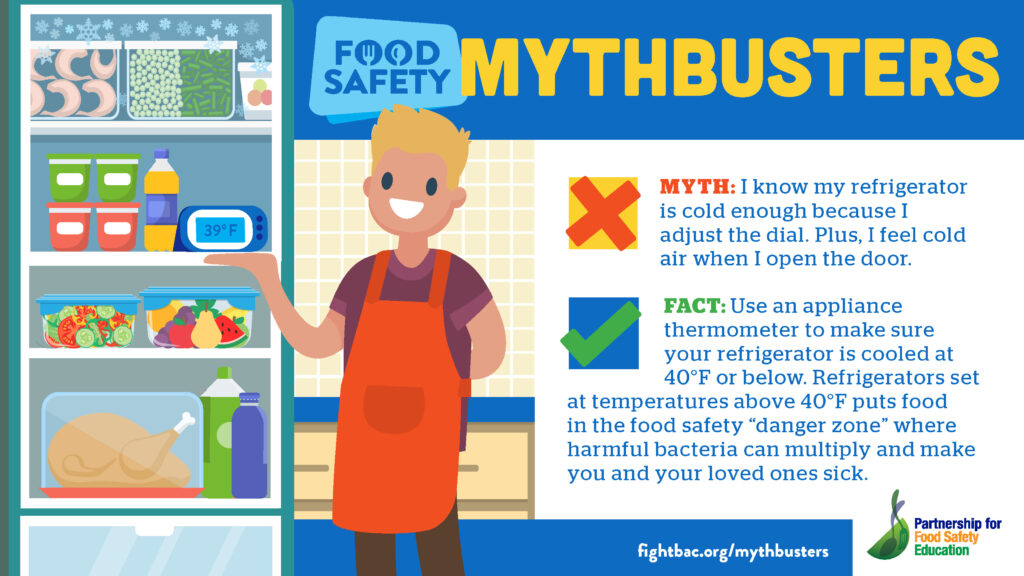
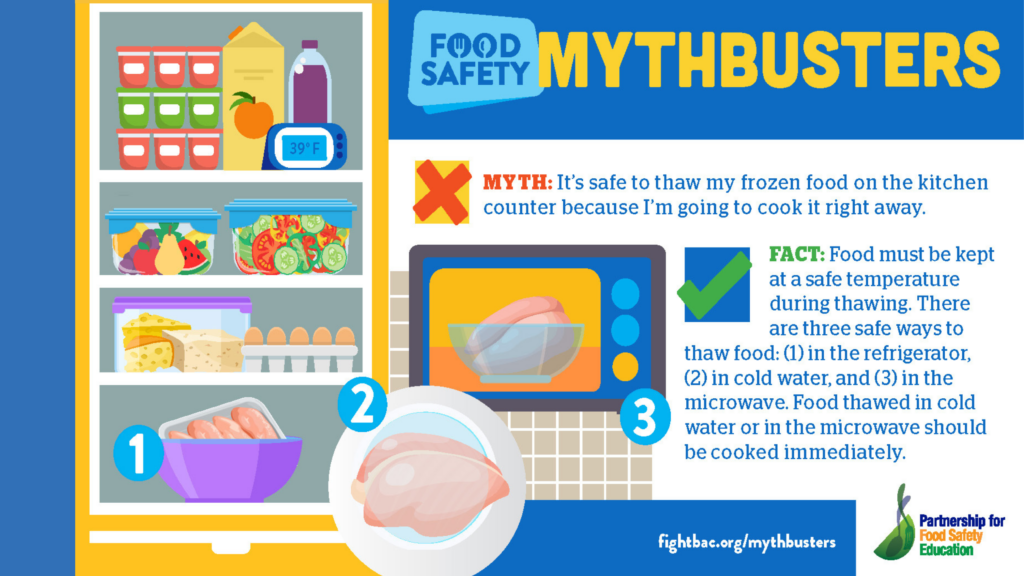
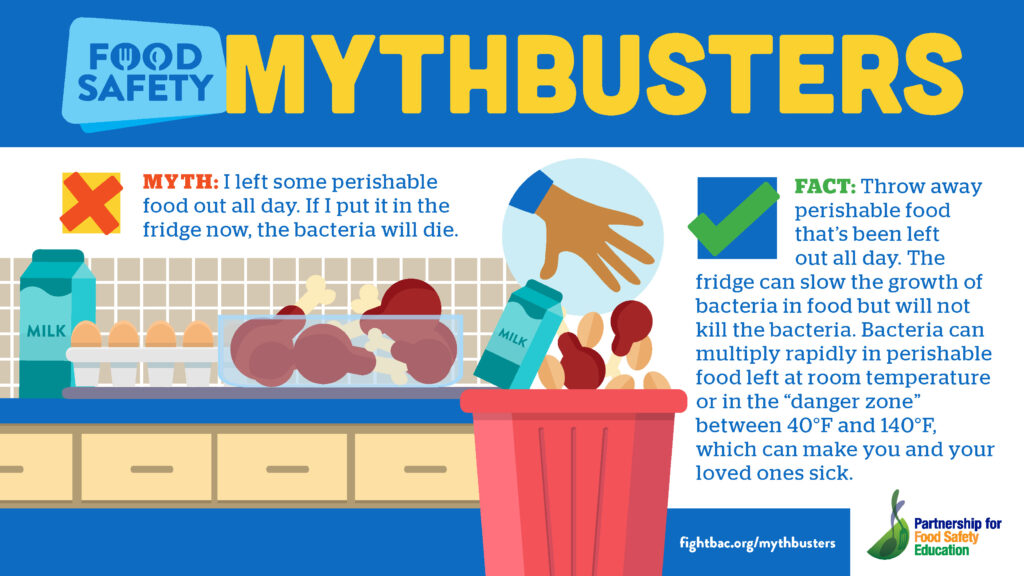
Many households enjoy cooking frozen and ready-to-eat convenience foods in a microwave oven. Follow these food safety steps when using a microwave.
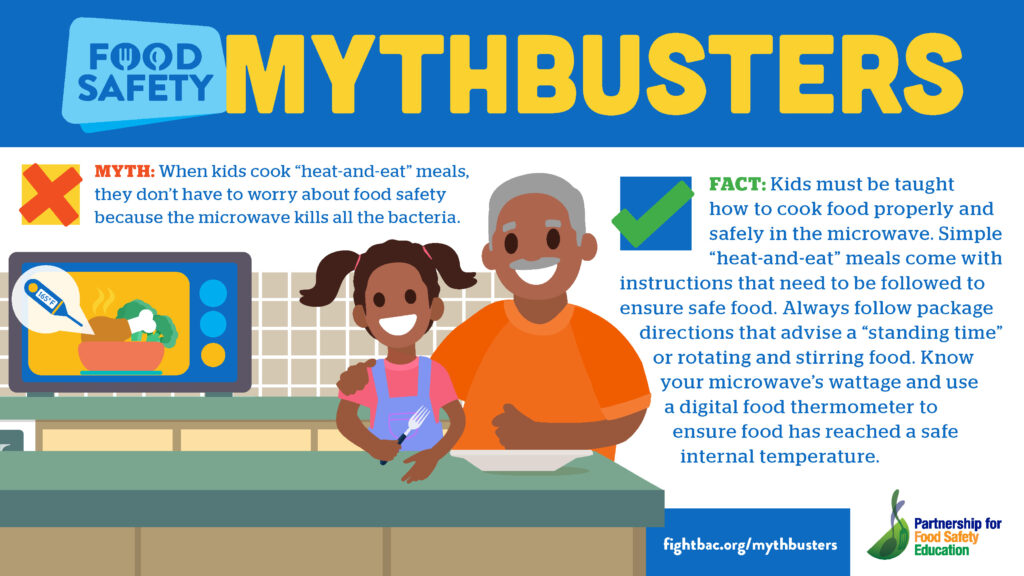
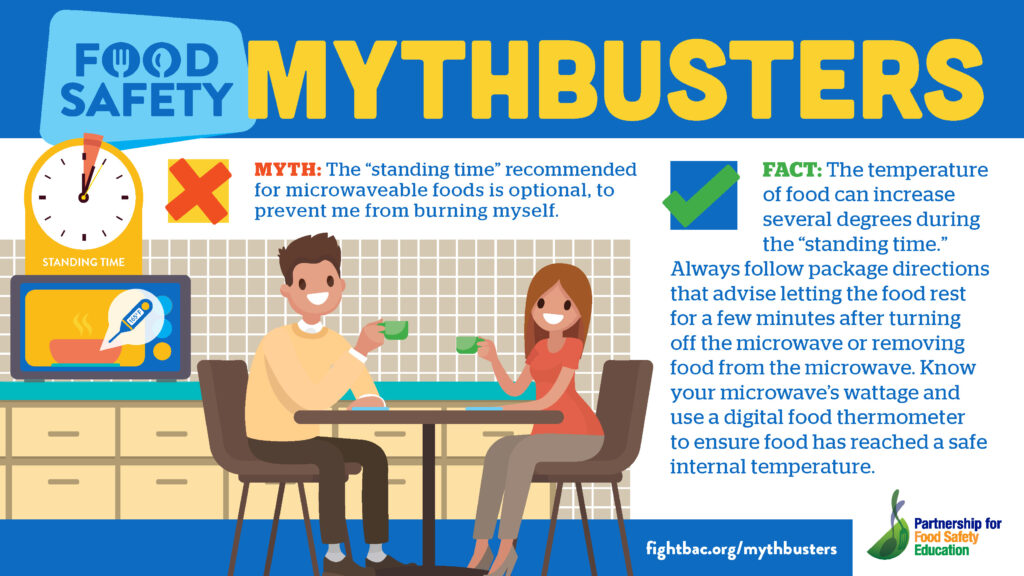

Fruits and vegetables are an important part of a healthy diet, but it’s important to select and prepare them safely. Follow these safe handling tips to protect yourself and your loved ones when enjoying fresh produce.
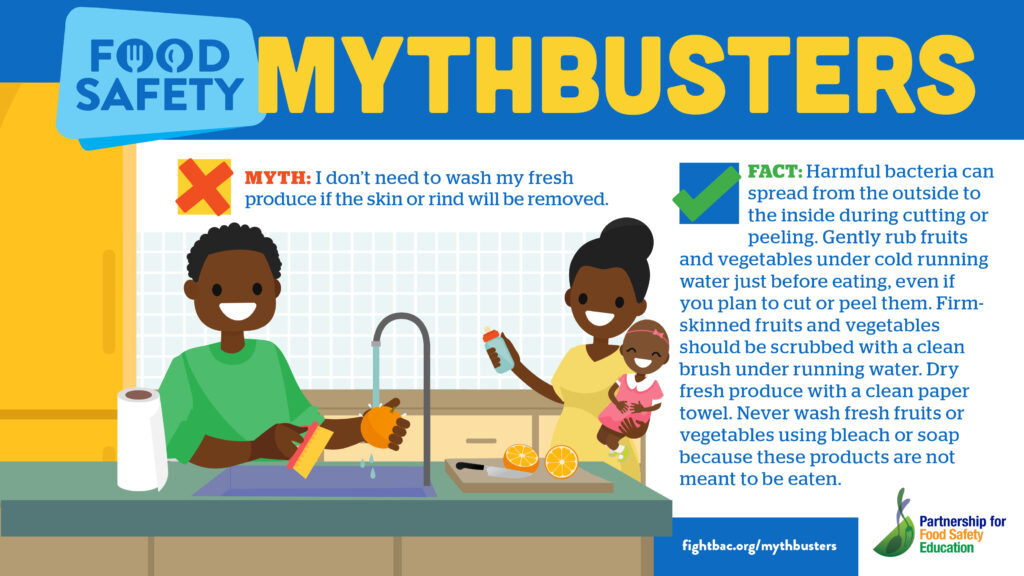

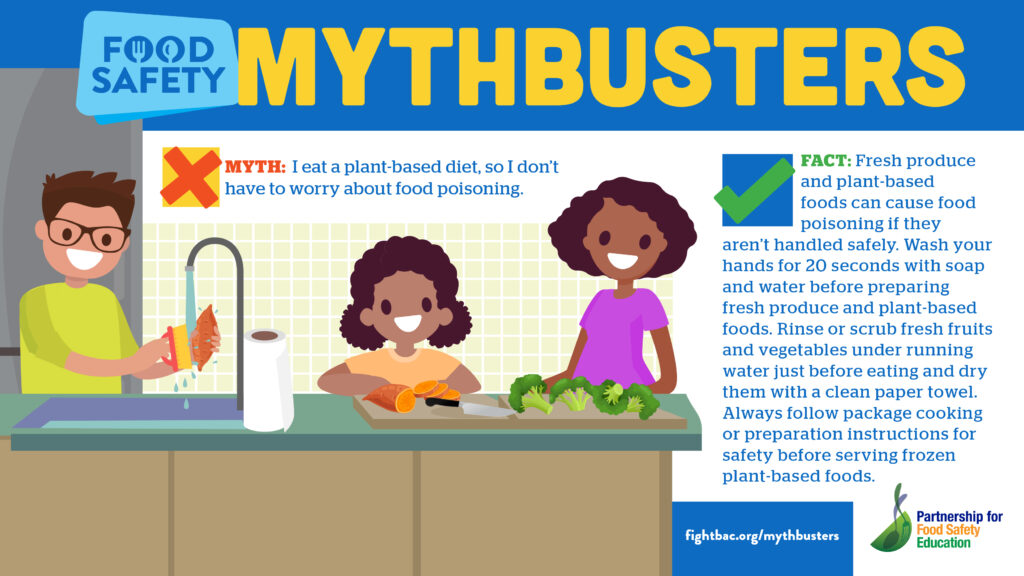
Raw meat and poultry can spread harmful germs to fresh produce and ready-to-eat foods — unless you keep them separate. Always cook meat and poultry until it reaches a safe internal temperature on a digital food thermometer.
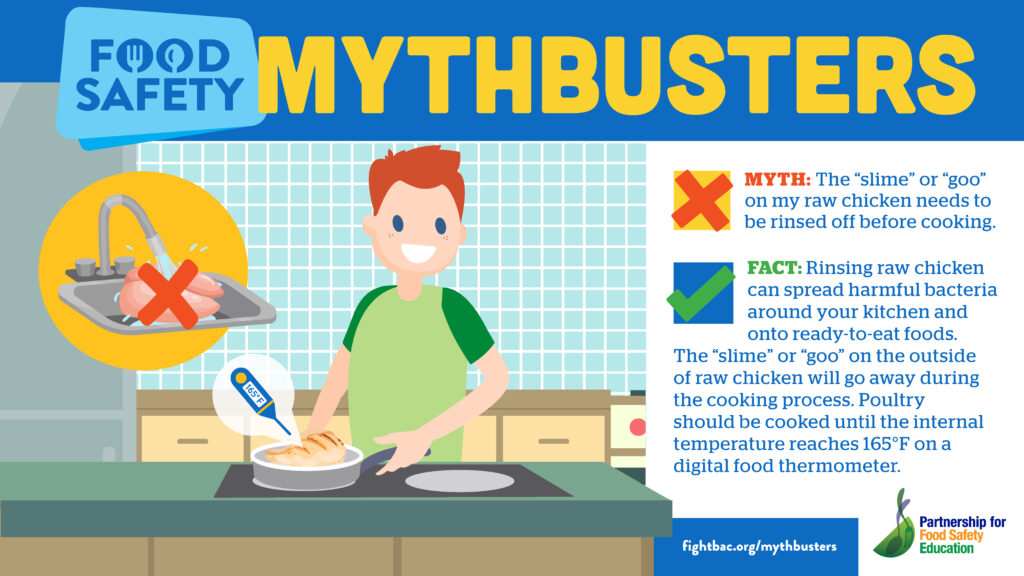
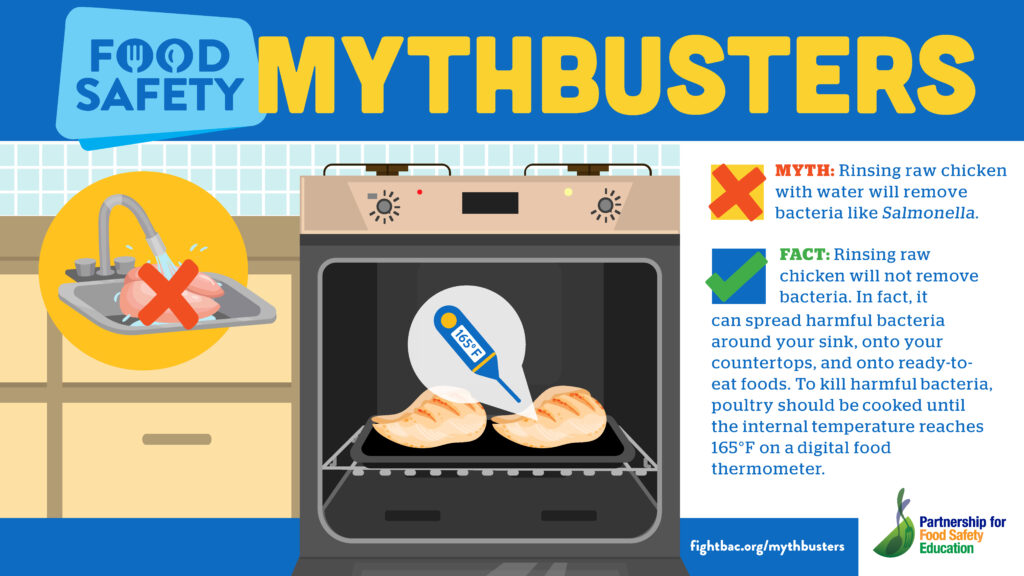
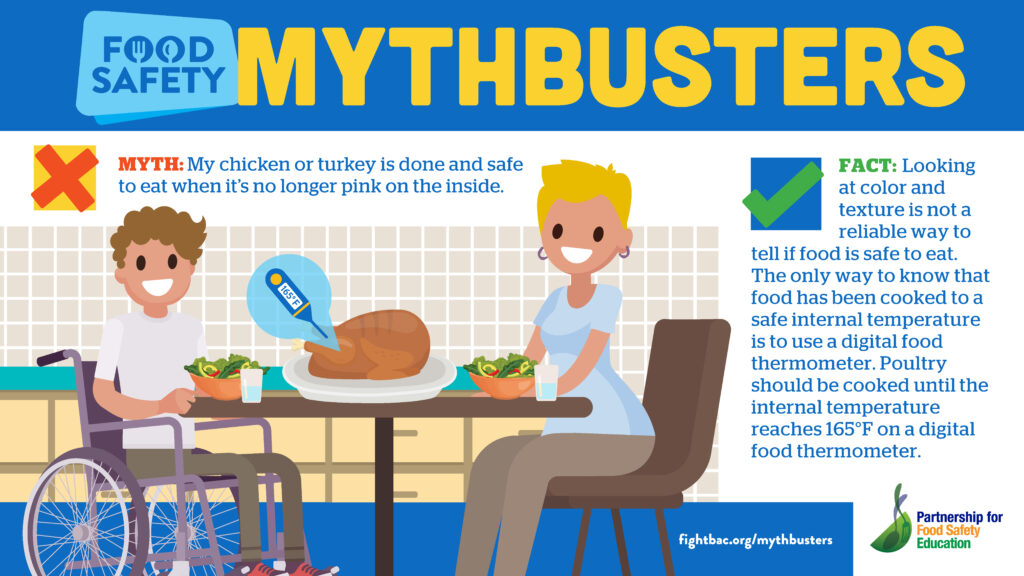
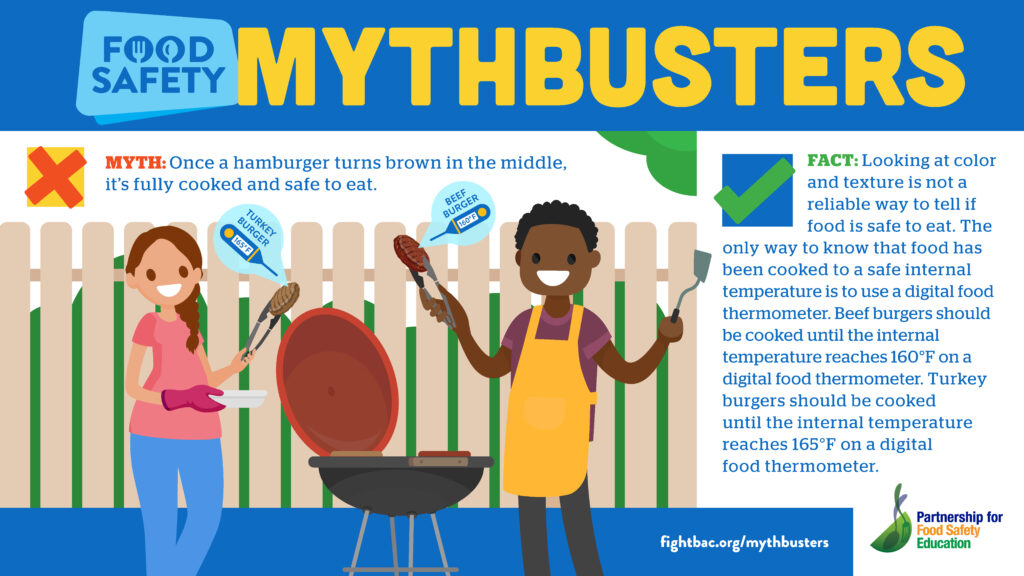
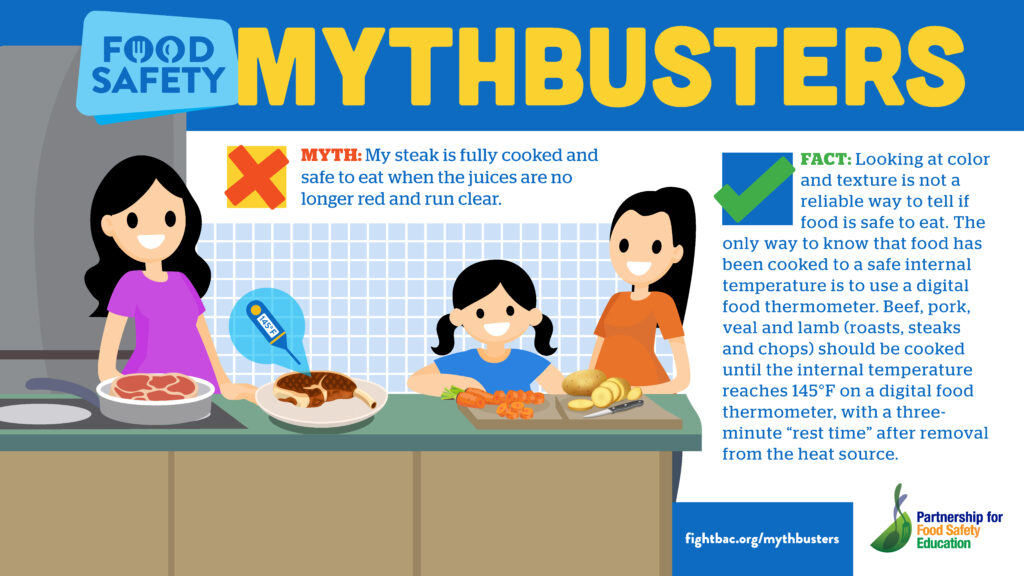
As the way we receive food changes, the core food safety practices remain essential to protecting our health and the health of those we love.
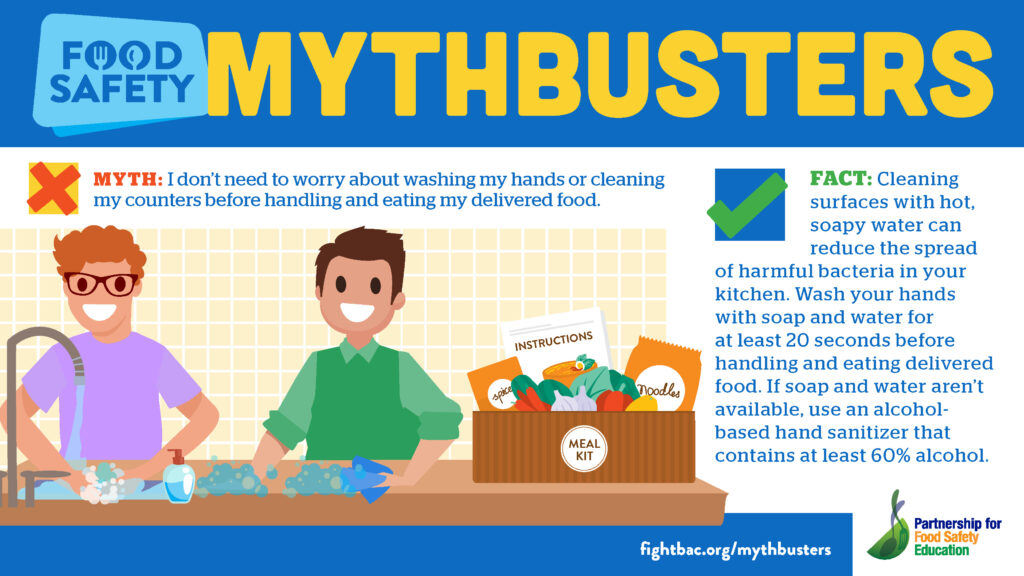
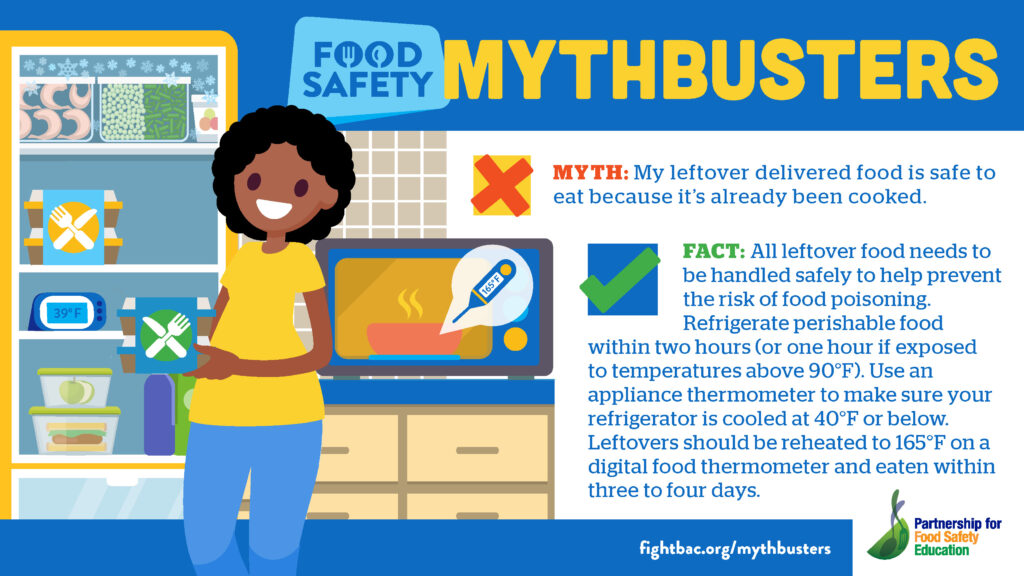
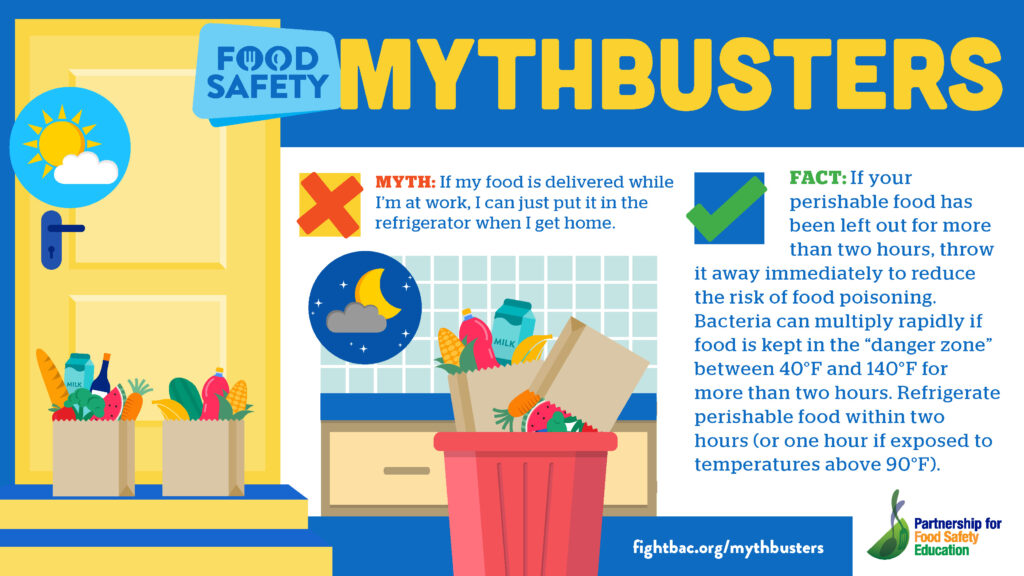
The Partnership for Food Safety Education recommends people not eat raw cake batter, cookie dough and other doughs, whether they come from a mix or are made from scratch.
Flour and other ingredients can contain harmful bacteria that are only killed during the cooking process. Children are especially vulnerable to serious foodborne illness.
Download this activation guide of easy tools to help you share safe flour handling messages in your outreach.
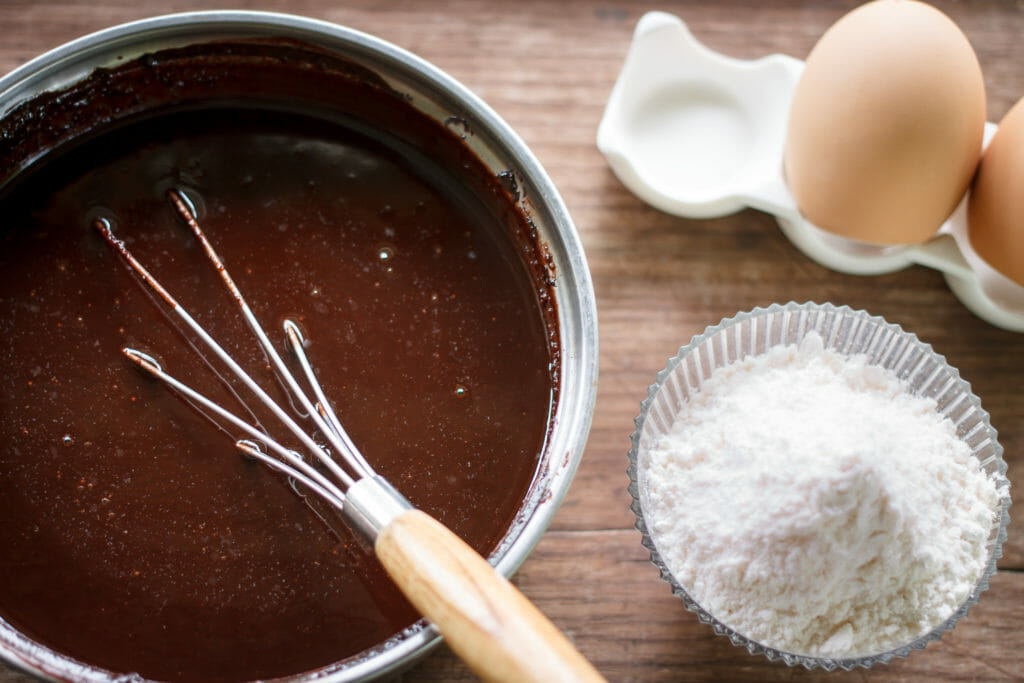
English
Español
Flour is a raw ingredient. Wheat comes from the farm, so it’s minimally processed and then packaged for use. Because it’s raw, flour may contain harmful germs, like E. coli and Salmonella, that cause food poisoning. Wash your hands with soap and water after handling raw flour to prevent it from spreading to other foods. Remember to wash bowls, utensils, countertops, and other surfaces that have touched raw flour with hot, soapy water.
Video courtesy of the North American Millers’ Association




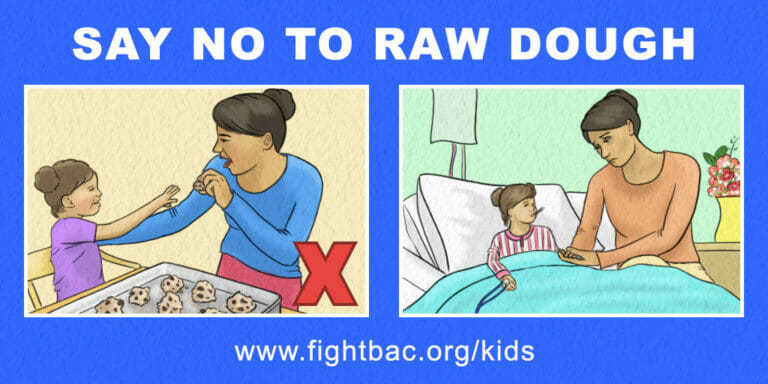
Say No to Raw Dough (shareable graphic)
Presenters: Donald Kautter, Senior Advisor/Consumer Safety Officer with the FDA; Sharon Davis, Family and Consumer Sciences Educator, Home Baking Association
Additional information on flour and home food safety:
Join our email list to stay up to date on home food safety.
October 15 is Global Handwashing Day!
Washing your hands is one of the most effective ways to prevent the spread of germs.
Studies have shown that handwashing can prevent 1 in 3 diarrhea-related sicknesses and 1 in 5 respiratory infections.
Learn how to properly wash your hands with soap and water, and show others how to practice good hand hygiene.
For Global Handwashing Day on Tuesday, October 15, let’s commit to promoting proper handwashing and hand hygiene! Here are some ways you can participate:

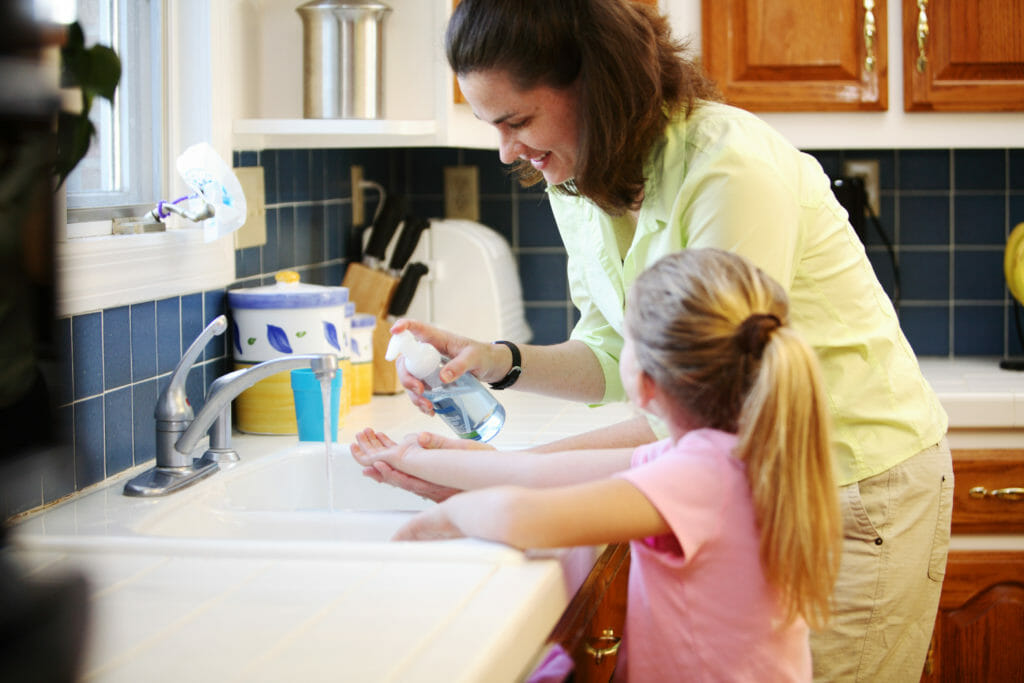
NEW! Common food safety myths originate from the misapplication of science, family tradition, or misinformation on social media.
The Partnership created these social media graphics for consumers and educators to help debunk common home food safety myths.
Brush up on safe food handling steps with these food safety Mythbusters!



Just in time for Global Handwashing Day, health, nutrition and food safety educators are invited to download and share these resources on social media and in your outreach.
The infographic (right) is available as a JPG file and printable PDF file.
These colorful social graphics teach families how to properly wash hands while preparing food and handling raw meat, flour and eggs.
Use these sample social media posts along with the graphics on this page. Let’s help educate families on proper hand hygiene!
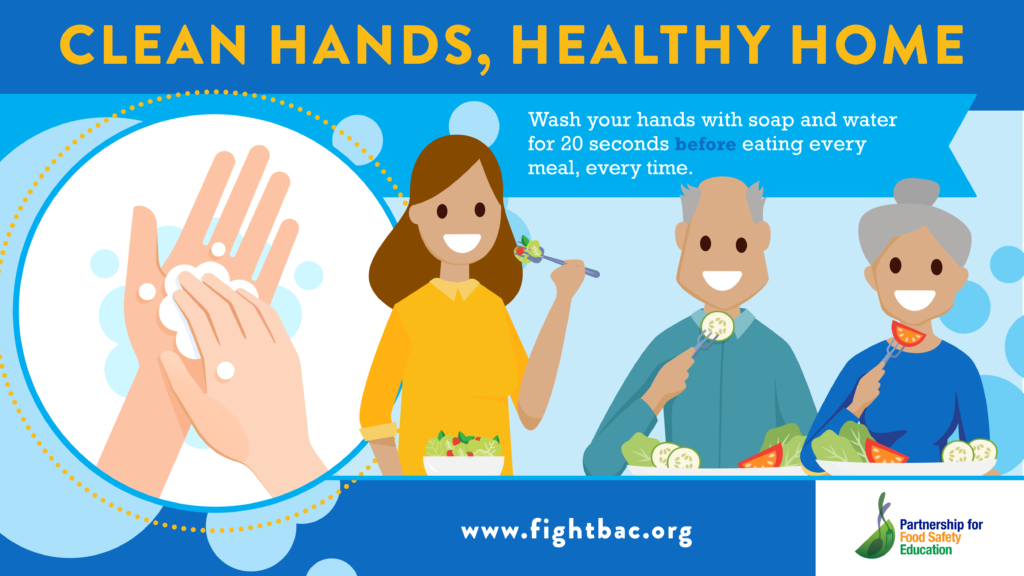
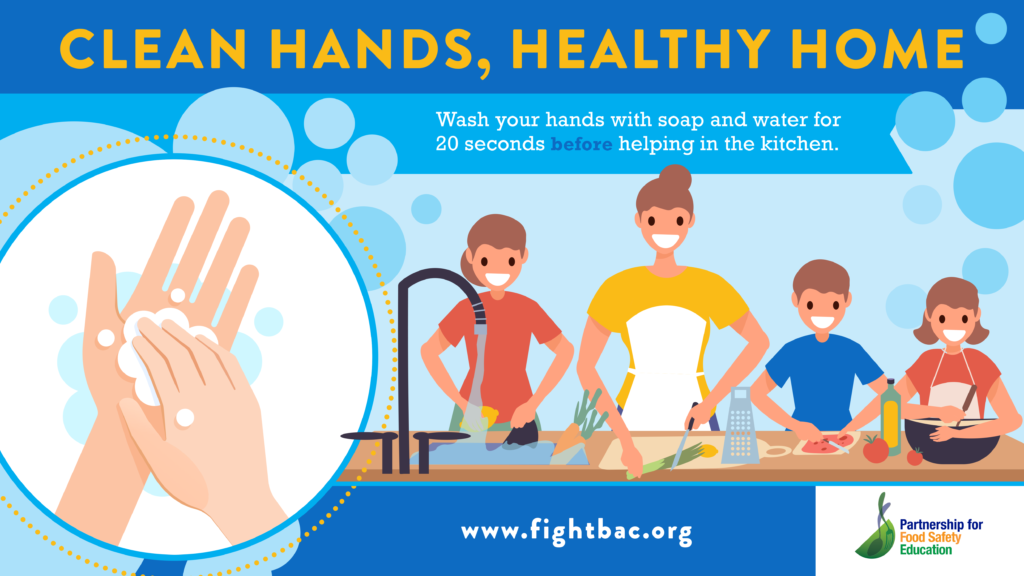
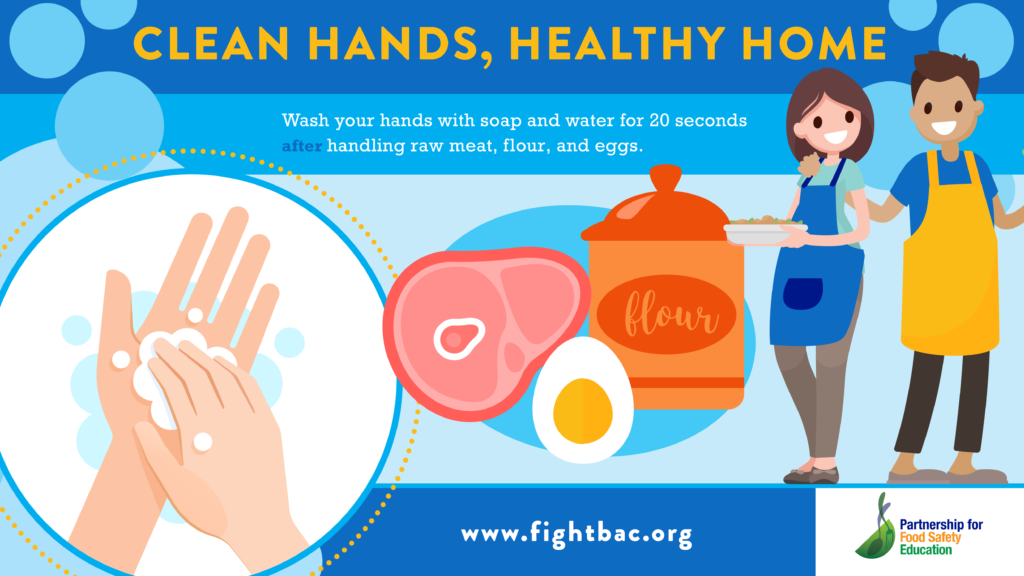
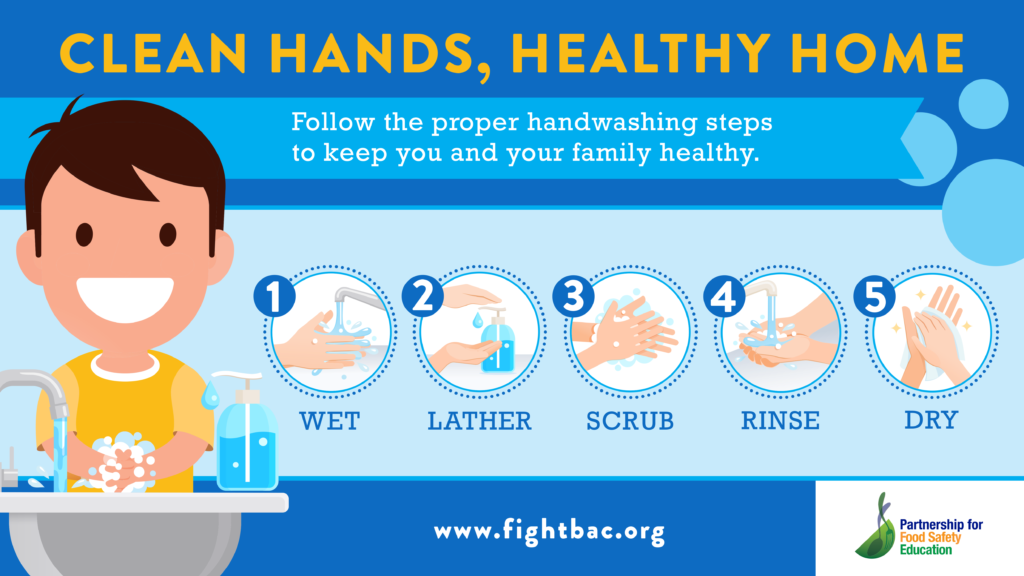
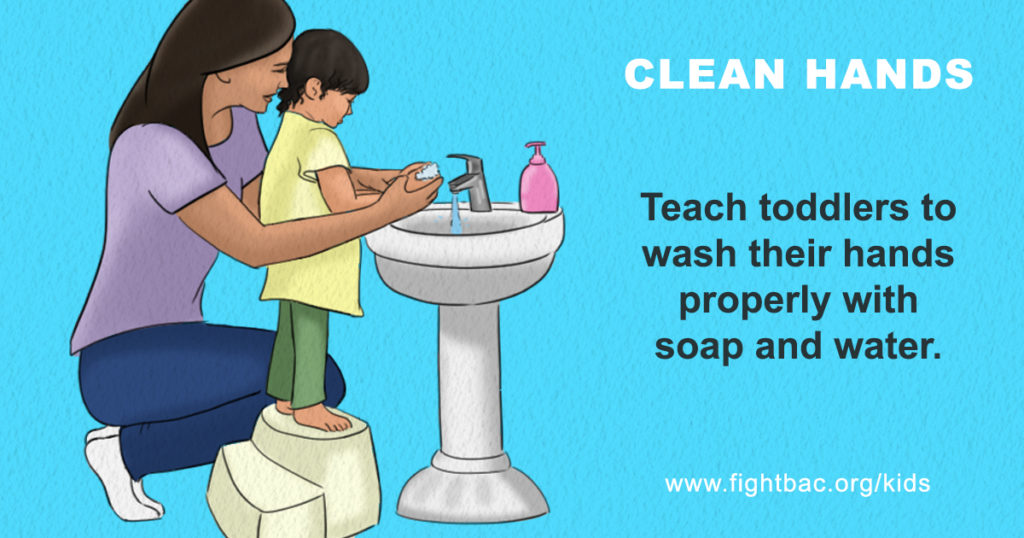
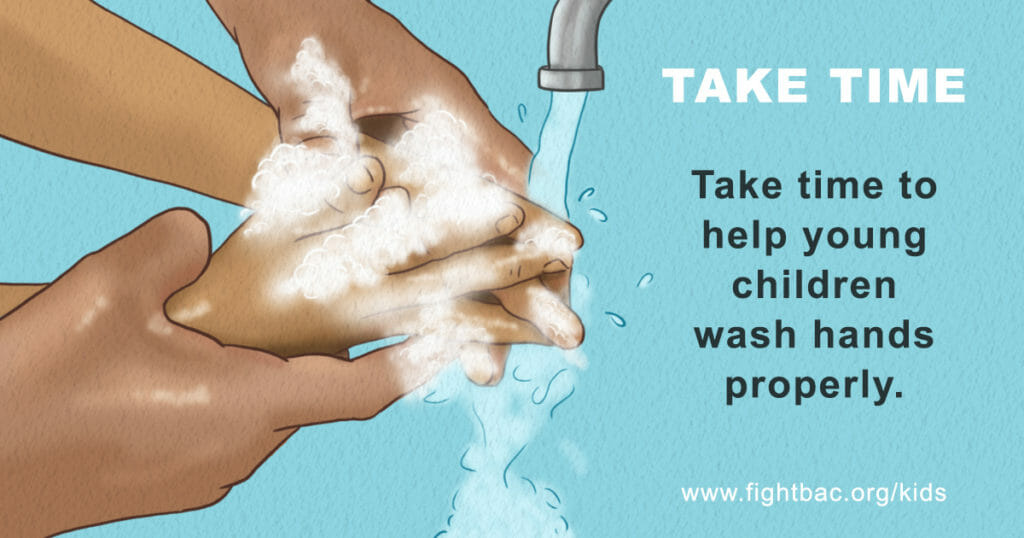
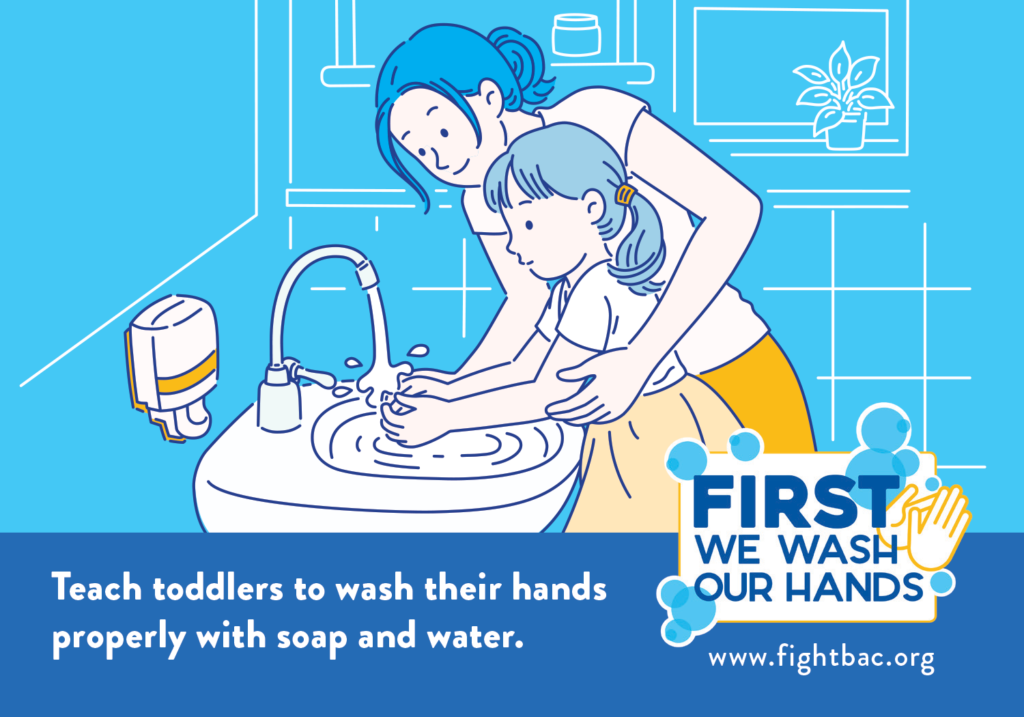
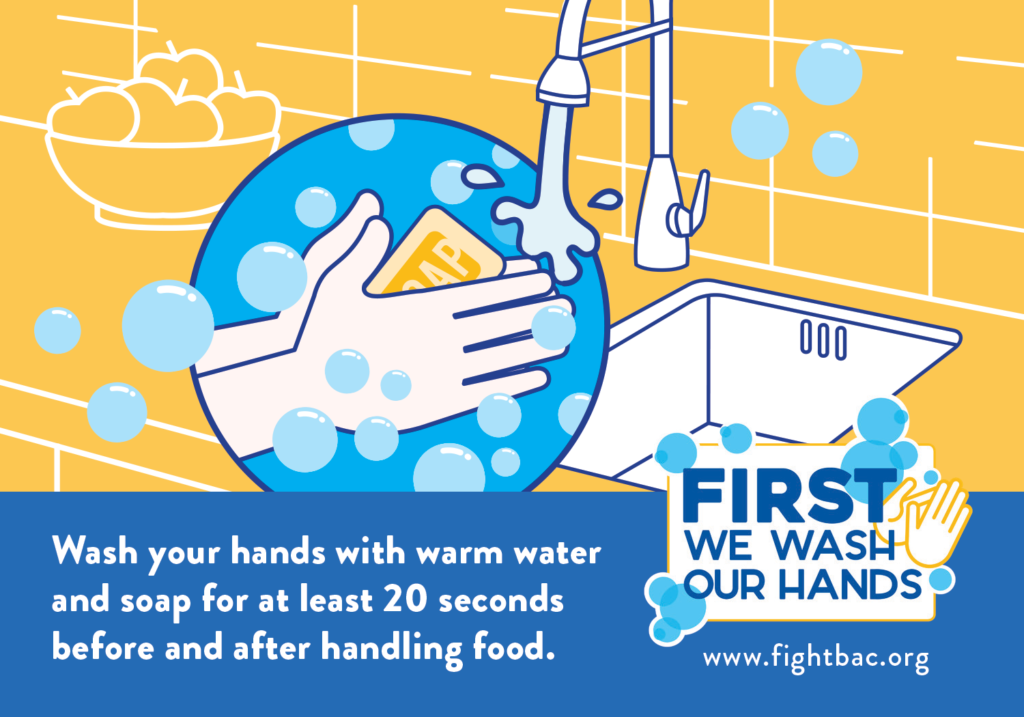
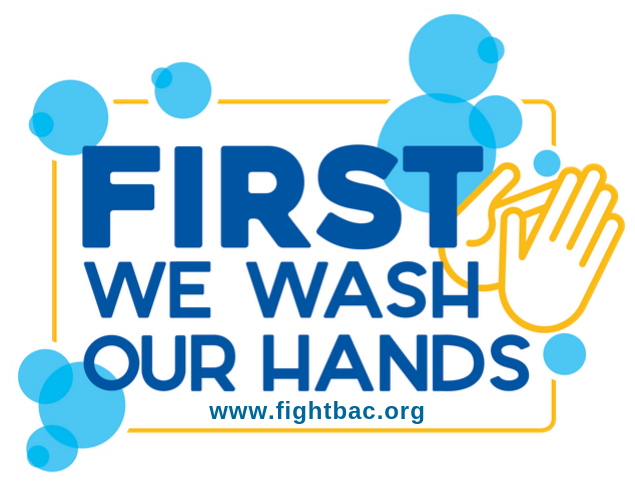
Know your role! As the way we receive food changes, the core food safety practices remain essential to protecting our health and the health of those we love.
Washing your hands is one of the most effective ways to prevent the spread of germs. Wash your hands with clean, running water and soap for at least 20 seconds before and after handling food. If soap and water aren’t available, use an alcohol-based hand sanitizer that contains at least 60% alcohol.
Learn more about the three simple steps you need to follow to keep your delivered food safe!
Food safety starts at home! Check out these free resources to help keep families healthy while preparing food at home.
These kid-friendly activities will help teach young ones how to properly wash their hands, as well as other food safety steps to help keep them healthy!
Global Handwashing Day was founded by the Global Handwashing Partnership, and is an opportunity to design, test, and replicate creative ways to encourage people to wash their hands with soap at critical times. Global Handwashing Day is celebrated every year on October 15th.